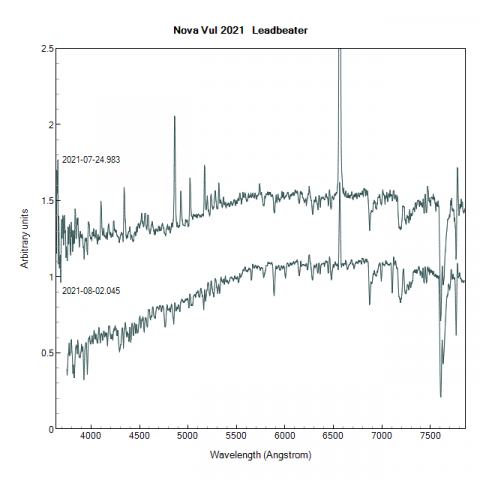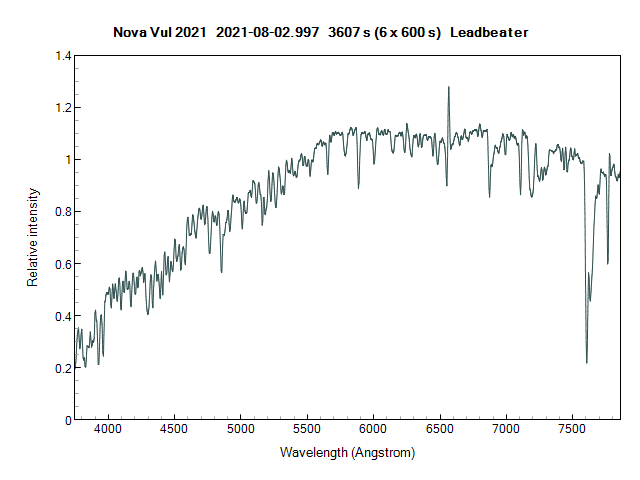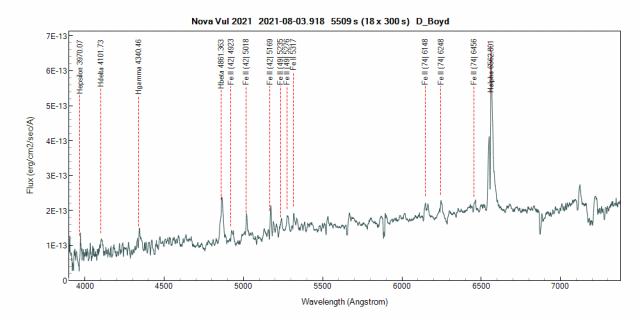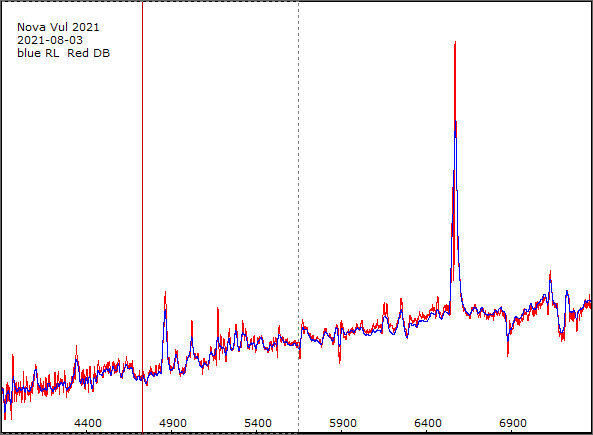› Forums › Variable Stars › Nova Vul 2021
- This topic has 30 replies, 9 voices, and was last updated 3 years, 10 months ago by
 Gary Poyner.
Gary Poyner.
-
AuthorPosts
-
31 July 2021 at 11:18 pm #584557
 Nick JamesParticipant
Nick JamesParticipantYes, 2021! Corrected and Yes, the CBET is from Dan Green.
1 August 2021 at 8:42 am #584477 Mike HarlowSpectator
Mike HarlowSpectatorJust had a quick look at the object through the objective prism and as Robin has shown above there are strong H alpha and beta emission lines.
2 August 2021 at 2:31 pm #584561 Robin LeadbeaterParticipant
Robin LeadbeaterParticipantThe spectrum has changed significantly in the past few days. Except for a relatively weak narrow H alpha emission, all the other lines previously in emission are now either missing or in net absorption.
Cheers
Robin
 3 August 2021 at 2:14 pm #584563
3 August 2021 at 2:14 pm #584563 Robin LeadbeaterParticipant
Robin LeadbeaterParticipantThe H alpha emission line has weakened further and is now showing a P Cygni profile (velocity ~600km/s). The rest of the spectrum now resembles that of a G/K star photosphere but with some additional absorption lines, particularly in the red at ~7106/7766 A (The other features in that area are Tellurics)
Cheers
Robin
 4 August 2021 at 1:27 am #584566
4 August 2021 at 1:27 am #584566 Robin LeadbeaterParticipant
Robin LeadbeaterParticipantSignificantly fainter in the spectrograph guider tonight and the spectrum has changed completely once again with a host of strong broad emission lines appearing.
Robin
4 August 2021 at 12:16 pm #584567 David BoydParticipant
David BoydParticipantLast night, 3rd August, I measured Nova Vul 2021 at V=10.97, B-V=1.14, almost a magnitude fainter than 48 hrs before and slightly redder. As Robin said, there has been a big change in the spectrum over recent days.
The following LISA spectrum (R~1062) was calibrated in absolute flux using this V magnitude and response corrected with the B9III MILES star HD192907 recorded at the same airmass as the mid-time of the nova spectrum. H-alpha has a strong P-Cyg absorption dip at -320 km/s which now falls within the much broader ~3000 km/s FWZI of the line. FeII multiplets 42, 49 and 74 are prominent with just-resolved P-Cyg dips. There are also emission features at ~5526A, ~5662A and ~7117A, all with P-Cyg dips, which I have not been able to identify in the WIlliams list of nova emission lines. Suggestions?
David
 4 August 2021 at 8:56 pm #584568
4 August 2021 at 8:56 pm #584568 Robin LeadbeaterParticipant
Robin LeadbeaterParticipantAgain excellent agreement with mine ~2 hrs later (using a different MILES reference star HD192640) though the the blueward absorption in the H alpha line is not resolved in the R 500 ALPY spectrum
Robin
 5 August 2021 at 12:01 am #584570
5 August 2021 at 12:01 am #584570 Lars LindhardParticipant
Lars LindhardParticipant
The nova is still about mag 11.
Here is a picture taken tonight about midnight here (UT + 2) 14″ sct + Canon 77d 10 sek.
5 August 2021 at 10:03 am #584571 Stewart John BeanParticipant
Stewart John BeanParticipantGot a series of seven 60 s images from iTEL 18 in Spain last night 2459431.46 . Airmass of about 1.016.
All seven are around 11.47 V mag using Vphot and AAVSO comp stars.
This is a bit of a fade over the last 2 days.
Stewart
8 January 2022 at 1:36 pm #585099 Jeremy ShearsParticipant
Jeremy ShearsParticipantUpdated light curve until end 2021. Currently 18th mag, but still ~4 mags above quiescence
 23 February 2022 at 4:54 pm #585266
23 February 2022 at 4:54 pm #585266 Gary PoynerParticipant
Gary PoynerParticipantThis Nova (V606 Vul) is brightening once again. Looking at the VSS database, it can be seen that the Nova has been slowly rising from mid December (Mag 18.9V on Dec 6), through January where Nick James was able to follow it to mag 14.76CG by Jan 31. I’ve just measured an image taken by SLOOH this morning (Feb 23) at mag 14.6C.
If you can get to the field at this time of year, please report your observations to the VSS.
Gary
-
AuthorPosts
- You must be logged in to reply to this topic.
